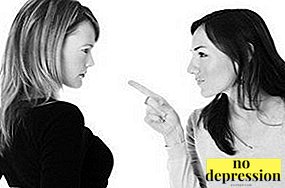Blue has always been associated with clear skies, peace, tranquility and joy.
In many works of art, the versatility of this color is celebrated.
Blue color in psychology It has characteristics similar to blue, but is almost devoid of gloom.
What does it symbolize, and what does it associate with?

Blue is a light shade of blue. Quite common in naturetherefore, it is perceived by the human psyche as natural and safe.
It has a wide range of shades, the most famous of which are ultramarine, Pervane, turquoise, azure, heavenly.
Interesting information about the blue color:
- Orthodoxy personifies blue with the Virgin Mary.
- The common phrase "blue dream" means a beautiful dream that is almost impossible to achieve.
This is due to the fact that blue has long been considered a color denoting perfection and a dream.
- Topaz personifies blue.
- Blue is the specific gray color of cats' fur, which is inherent in certain breeds, for example, the Russian blue cat.
- On the skin of people sometimes there are nevi (moles) of blue color. Sometimes they can be dangerous, but in most cases they are harmless, although the probability that they can turn into melanoma is higher than in the case of regular brown moles.

The most common association with blue is sky.
The skies in sunny weather are painted in a rich blue color, sometimes falling into blue.
The clear sky has long been was considered a good sign since they did not foreshadow troubles in the form of thunderstorms, hail, snow, which could seriously complicate the lives of people of the past.
A large number of flowers are colored blue, for example cornflower, chicory, proleska, delphinium, forget-me-nots, blue flax, some varieties of plants such as lilac, poppy, bells, petunia, iris, ageratum.
Many people at the thought of blue will remember about Malvina's hair from the children's fairy tale "The Golden Key" and its prototype, the Blue Fairy from Pinocchio. These two characters serve primarily to push the main character to the light.
Blue is a personification peace, hope, kindness, light, intellect, tranquility, confidence, happiness, loyalty, safety, inspiration, spirituality, dream, harmony, creativity, wisdom, and the desire for knowledge.
This is a bright and cozy color, which extremely rarely causes negative emotions in people.
What does blue color mean in psychology? Find out about this from the video:
What is used in advertising?

Blue has become closely associated over the past decades. male (mostly with underage men) thanks to the activities of marketers.
For this reason, it can be found in advertising toys and clothes for boys of different ages, it is also actively used in coloring products for this group of people.
Him usually combine with green, white, black, blue, orange, red. Pink shades in this kind of advertising are not used.
This color and other shades of blue are widely used in the design of software and websites, because they do not cause irritation and are closely associated by users with intelligence, creativity and harmony.
For example, the main color of the social network Twitter is exactly blue, like their logo.
In product advertising for creative people and intellectuals In general, blue is irreplaceable, as well as other cold shades, such as blue, violet, indigo. People associated with creativity, often prefer cold colors.
Too much blue in advertising can cause a potential consumer boredomtherefore, it is recommended to use it moderately and work on contrasts to make the shade look harmonious.
Since blue is associated with people with calm, relaxation, safety, it is often used for coloring bed linen and other items that create a feeling of comfort. It is advisable to use blue in advertising these things.
Impact on the psyche

Cold shades always affect the human psyche soothingly, peacefully warm ones, on the contrary, cause mental excitement, give a burst of energy, strengthen emotions.
Blue color refers to the cold part of the color spectrum, but it affects the psyche much softer than blue or purple, and rarely causes discomfort.
Features of the effect of blue on well-being:
- This color has a soothing effect on the psyche, softens aggressiveness and irritability, improves mood, causes a feeling of security and confidence.
He is also able to set up a person to gain knowledge, strengthen his cognitive activity. For this reason, blue walls often paint walls in schools.
- Blue beneficial effect on cognitive abilities person: improves memorization and thinking, enhances concentration. In a blue setting it is easier to formulate thoughts.
- Improves the ability to fantasize, is able to cause inspiration, helps to come up with creative ideas and implement them. Also, blue enhances aesthetic feelings of a person.
- Renders positive effect on mood, able to improve the condition of a person with mental diseases. Reduces the severity of phobias and neurosis, improves the process of falling asleep, softens the severity of emotional lability, helps to fight stress.
- According to color therapy - the direction in alternative medicine - blue is capable lower blood pressure and temperature, slow heart rate, reduce the severity of pain, positively influence the work of the bone, respiratory, immune and muscular systems, organs of vision, improve the condition in case of infectious diseases, reduce itching and other unpleasant sensations.

If you like blue: what does it mean?
There is a connection between color preferences and his personality, character, therefore favorite color can tell a lot about a person.
Blue is found attractive by a large number of people, but its dark shades are more often found attractive by men, and light - by women.
Both men and women who prefer blue color have approximately the same features of character. Among them:
- The love of creativity. People who love blue often choose different types of creativity as a hobby and try to devote as much time as possible to them. Some of them are so imbued with creativity that they are doing everything possible so that their passion brings them enough money. Not always such people seek fame, but their abilities allow them to get it.
- Developed intelligence. Blue is chosen by people positively related to science and its achievements. Unlike those who love purple and its shades, lovers of blue and blue rarely addicted to pseudoscience, usually do not believe in conspiracy theories and in the supernatural. The sphere of interests of the "blue" people is natural science and humanitarian, but among them there are enough those who preferred the exact sciences.
- Equilibrium. People who love blue usually have an even emotional background and are well able to control it, if necessary. They prefer to make decisions based on reason, rather than feelings.
- Purposefulness. They know how to work hard to achieve their goals, and since their emotional background is fairly even, it does not prevent them from concentrating on solving primary tasks.
Women who love blue color, more often than others, put work in priority, rather than family.
- Vulnerability, hypersensitivity. Despite their seemingly low emotionality, "blue" people react painfully to the negative events occurring in their lives. They also have a predisposition to the development of a variety of mental diseases. Among them are many pessimists and realists.
- Perfectionism. Blue symbolizes perfection, and perfectionists aspire to it with all their might and suffer if the result of their work seems to them to be insufficiently perfect.
- Unsociability These people prefer to be alone or in a narrow circle of close friends. This is their key to comfort and tranquility. However, it is difficult to call them reclusive: they are ready to communicate and have well-developed communication skills, but a long stay in the crowd and the need to communicate a lot exhaust them.


People who love the light blue color, often need to communicate and not always easily tolerate loneliness.
Blue color eyes image maker:
What does color hostility mean?
Certain features of character are present in those who dislikes blue, such as:
- Aggression, imbalance. It is difficult for them to control themselves, they explode easily and cool down just as easily. Such people are over-active, striving to do as much as possible.
- Impulsiveness. They quickly make decisions, guided by emotions, not reason, they can hardly be called rationalists.
Also people who do not like blue color, withfalsely called dreamers.
Who is suitable?

Blue - color of intellectuals and creative people, those who strive for knowledge and have made self-improvement their main goal in life.
Blue clothes are good suitable for dreamers and visionaries.
A translucent blue dress will make a girl more elegant and emphasize her sophistication, and a dark blue tie or scarf will be a good option for a young man who watches himself.
This color blends well with:
- white;
- black
- dark blue;
- grass green;
- peach;
- beige;
- cream;
- orange;
- dark brown.
Blue color is almost created for rooms designed for recreation, therefore it is often used when decorating a bedroom.
This design will help a person easier to fall asleep and reduce his nervousness after work.
But, as is the case with other colors, it’s important not to overdo it: An abundance of blue, not diluted with contrasting colors, can look dull and tedious.
Blue color in the interior:
Negative value in psychology

People who prefer blue have the following negative traits:
- easy infantilism;
- excessive love of wandering in the clouds;
- arrogance.
For some people, the blue color has depressing effect, contributes to the emergence of depression, depression, anxiety, reduces the ability to work.
But this negative impact is expressed very weakly, if the blue color is successfully complemented by other colors.



